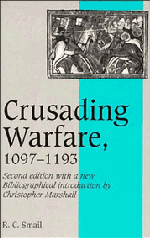Book contents
- Frontmatter
- Contents
- List of plates
- List of maps
- List of plans
- Preface (1954)
- List of abbreviations
- Bibliographical introduction (1994)
- I The historians of crusading warfare
- II Warfare and policy in Latin Syria
- III Franks, Armenians, and Syrians
- IV The Muslim armies
- V The Latin armies
- VI The Latin field army in action
- VII The Crusaders' castles
- Bibliography
- Bibliography to the second edition
- Index
- Plate section
I - The historians of crusading warfare
Published online by Cambridge University Press: 29 September 2009
- Frontmatter
- Contents
- List of plates
- List of maps
- List of plans
- Preface (1954)
- List of abbreviations
- Bibliographical introduction (1994)
- I The historians of crusading warfare
- II Warfare and policy in Latin Syria
- III Franks, Armenians, and Syrians
- IV The Muslim armies
- V The Latin armies
- VI The Latin field army in action
- VII The Crusaders' castles
- Bibliography
- Bibliography to the second edition
- Index
- Plate section
Summary
SCOPE OF THE SUBJECT
The military achievements of the Crusaders during the twelfth century form a complete chapter in the history of medieval warfare. Its beginning is the foundation of the Latin states in Syria as a result of the First Crusade; its middle is the story of their expansion and then of their defence against Muslim states based on Aleppo, Damascus, and Egypt; the end lies in the events of the Third Crusade, when the joint strength of the Latin kingdom and the reinforcements from western Europe could recover only a few of the towns and territories lost to Saladin in 1187 and 1188. Throughout the period there is reasonable though not complete continuity both in the succession of military events and in the recording of them by contemporaries who travelled or made their home in Latin Syria, and who were sometimes eyewitnesses of the events they described. Generally speaking, the wars were fought around one main issue: the existence of the Latin states. They took place in one theatre: the lands which lie between the eastern end of the Mediterranean and the Syrian desert. Throughout the period the opposing armies preserved the same essential characteristics in organization, arms, and tactics, and these elements of unity and continuity appear to make possible a single and connected exposition of this warfare by the military historian.
- Type
- Chapter
- Information
- Crusading Warfare, 1097–1193 , pp. 1 - 17Publisher: Cambridge University PressPrint publication year: 1994

